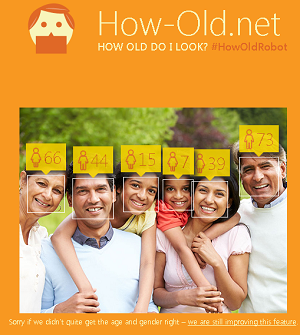Microsoft Finds New Use for Database: Guessing Your Age
Forget all that techy Azure Big Data stuff -- Microsoft found a new way to put databases to work that's really interesting: guessing your age from your photo.
Threatening to upstage all the groundbreaking announcements at the Build conference is a Web site where you provide a photo and Microsoft's magical machinery consults a database of face photos to guess the age of the subjects.
Tell me you didn't (or won't) visit How-Old.net (How Old Do I Look?) and provide your own photo, hoping the Azure API would say you look 10 years younger than you are?
I certainly did. But it couldn't find my face (I was wearing a bicycle helmet in semi-profile), and then I had to get back to work. But you can bet I'll be back. So will you, right?
(Unless you're one of those fine-print privacy nuts.)
Why couldn't Ballmer come up with stuff like this? Could there be a better example of how this isn't your father's Microsoft anymore?
Microsoft machine learning (ML) engineers Corom Thompson and Santosh Balasubramanian explained in a Wednesday blog post how they were fooling around with the company's new face-recognition APIs. They sent out a bunch of e-mails to garner perhaps 50 testers.
 [Click on image for larger view.]
How Old Do I Look? (source: Microsoft)
[Click on image for larger view.]
How Old Do I Look? (source: Microsoft)
"We were shocked," they said. "Within a few hours, over 35,000 users had hit the page from all over the world (about 29k of them from Turkey, as it turned out -- apparently there were a bunch of tweets from Turkey mentioning this page). What a great example of people having fun thanks to the power of ML!"
They said it took just a day to wire the solution up, listing the following components:
- Extracting the gender and age of the people in the pictures.
- Obtaining real-time insights on the data extracted.
- Creating real-time dashboards to view the results.
Their blog post gives all the details about the tools used and their implementation, complete with code samples. Go read it if you're interested.
Me? It's Friday afternoon and the boss is 3,000 miles away -- I'm finding a better photo of myself and going back to How-Old.net. I'm sure I don't look a day over 29.
In fact, I'll do it now. Hold on.
OK, it says I look seven years older than I am. I won't even give you the number. Stupid damn site, anyway ...
Posted by David Ramel on 05/01/2015